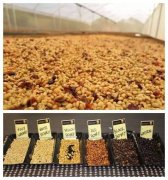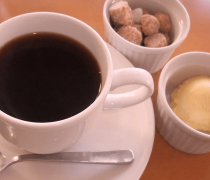Costa Rican double fermented raisin treatment, Costa Rican coffee worth a try

Professional barista communication, please pay attention to coffee workshop (Weixin Official Accounts cafe_style)
[Double fermented honey treatment] Treatment method: [100%] The treatment method of retaining the viscous layer and no water. On the day of harvest, the method of peeling and retaining the viscous substance is carried out, and then dried. The black honey treatment of the unique variety of Huangkaduai in the estate is named raisin treatment. The overall taste is rich and full of fat feeling plus cleanliness. The sweetness performance is excellent.
This batch is produced in Costa Rica's famous Tarrazu, Canet is located in Costa Rica's Tarrazu coffee growing area, which is the most concentrated fruit growing area in Costa Rica. The manor owner mainly grows passion fruit, the amount of coffee is quite small, only in a special area to grow coffee, take special care, only pick mature coffee yellow fruit, the manor's unique variety of yellow kaduai honey treatment named Baha, the overall taste of rich changes and full of fat feeling plus cleanliness! Excellent sweetness performance, berry to citrus fruit acid changes, rich and varied layers
Honey processing, called the Honey Process or Miel Process, is a method of drying the fruit with the endocarp after peeling the pulp. Coffee plantations in Costa Rica, Panama and Guatemala all use this treatment.
The honey treatment method began in Costa Rica as a method tried by local coffee farmers to improve the quality of coffee beans, and slowly spread to other countries. So why did Costa Rican farmers try this process? Since farmers earn most of their income from trading coffee beans, the better the quality of the beans, the more profitable they are, so it's no surprise that farmers keep trying new processing methods.
For a coffee producing area, there are three ways to improve the quality of coffee beans: first, improve the processing method; second, change the tree species planted; and third, improve the soil of the farm, which is the migration farm. But just like when we extract coffee, we will first adjust the extraction amount, pressure and temperature before changing the amount of coffee powder and grinding degree. We will first choose to change the conditions that can save time and cost as much as possible. Changing tree species and moving farms is time-consuming for farmers, so improving processing methods is their first choice.
Requirements for honey treatment:
Honey treatment is a complex, time-consuming and difficult processing method.
The first step is to select the best fruit, then peel off the flesh to leave the endocarp, which is the core of the honey treatment. The endocarp is rich in sugar and sourness, which slowly penetrate into the beans during drying.
The second step is drying, which is also the most important condition for producing high-quality coffee beans. The drying time is very important, if the time is short, the sweetness is not good; after a long time, the coffee will be moldy, and extra care is needed.
Photo from Cupping Spoon
What is the difference between yellow honey, red honey and black honey?
According to the thickness of pectin removal, the length of sun exposure (or drying thickness), the frequency of turning during drying, etc., honey treatment is divided into black honey, red honey, orange honey, yellow honey and white honey.
According to the thickness of pectin removal is divided into black honey, red honey, yellow honey:
Black honey: almost no pectin removal, so the longest drying time, need to last more than 14 days, in order to avoid drying too fast, will use a cover to block too strong sunlight, so that sugar conversion more fully.
Red honey: remove 25% pectin (specific practices vary from manor to manor), sun lasts for about 12 days, and shade may be used during the process
Yellow honey: remove 40% pectin, accept the most light drying, lasting about 8 days
There are also black honey, red honey and yellow honey according to the frequency of turning when drying.
For example, Costa Rica's Las Lajas Estate, 100% pectin retention,[yellow honey]: coffee placed on a shelf and turned once an hour;[red honey]: coffee turned several times a day, not as frequently as yellow honey;[black honey]: turned once a day.
For example, in El Salvador Glory Manor, yellow honey and white honey retain 20-30% pectin, depending on the drying thickness and turning times,[yellow honey]: thick layer drying, less turning times, drying time;[white honey]: thin layer drying, turning times, drying time is short.
orange honey
This is derived from traditional honey processing methods.
The fully ripe fruit is picked, picked, and pulped, just as it is washed, but with the exception of a certain amount of pulp juice, which is then dried in the sun bed and left on the "parchment." Leaving a certain amount of juice behind creates a brighter flavor for the coffee.
Brief summary:
Sweetness: Black honey> Red honey> Yellow honey> White honey
Cleanliness: White honey> Yellow honey> Red honey> Black honey
Balance: red/yellow honey> black/white honey
Important Notice :
前街咖啡 FrontStreet Coffee has moved to new addredd:
FrontStreet Coffee Address: 315,Donghua East Road,GuangZhou
Tel:020 38364473
- Prev

Why is Costa Rican Coffee Honey Treated Popular?
Professional barista communication, please pay attention to coffee workshop (Weixin Official Accounts cafe_style) honey treatment method, called HoneyProcess or MielProcess, honey treatment is the method of drying the fruit with endocarp after peeling the pulp. Coffee gardens in Costa Rica, Panama and Guatemala all use it
- Next

2017 bidding lot of Pacamara, the most expensive coffee in Guatemala.
For professional baristas, please follow the Coffee Workshop (official Wechat account cafe_style) country: Guatemala level: SHB Manor: Incht Manor Baking degree: medium Baking method: washing Variety: Pacamara batch: bidding lot Pandora Fatima EI07 Flavor: chestnut, plum, chocolate Guatemalan account Palamara bidding lot Pandora method
Related
- Detailed explanation of Jadeite planting Land in Panamanian Jadeite Manor introduction to the grading system of Jadeite competitive bidding, Red bid, Green bid and Rose Summer
- Story of Coffee planting in Brenka region of Costa Rica Stonehenge Manor anaerobic heavy honey treatment of flavor mouth
- What's on the barrel of Blue Mountain Coffee beans?
- Can American coffee also pull flowers? How to use hot American style to pull out a good-looking pattern?
- Can you make a cold extract with coffee beans? What is the right proportion for cold-extracted coffee formula?
- Indonesian PWN Gold Mandrine Coffee Origin Features Flavor How to Chong? Mandolin coffee is American.
- A brief introduction to the flavor characteristics of Brazilian yellow bourbon coffee beans
- What is the effect of different water quality on the flavor of cold-extracted coffee? What kind of water is best for brewing coffee?
- Why do you think of Rose Summer whenever you mention Panamanian coffee?
- Introduction to the characteristics of authentic blue mountain coffee bean producing areas? What is the CIB Coffee Authority in Jamaica?

